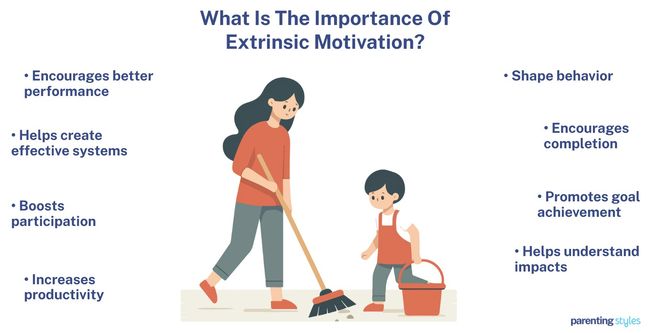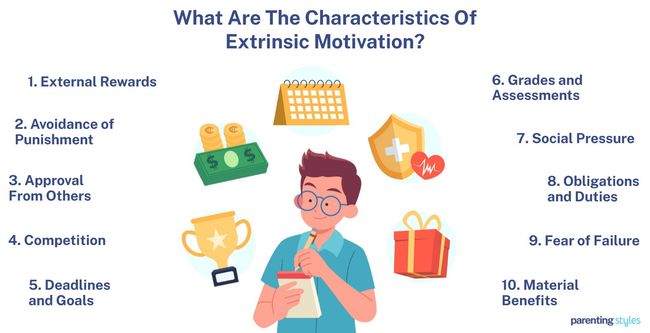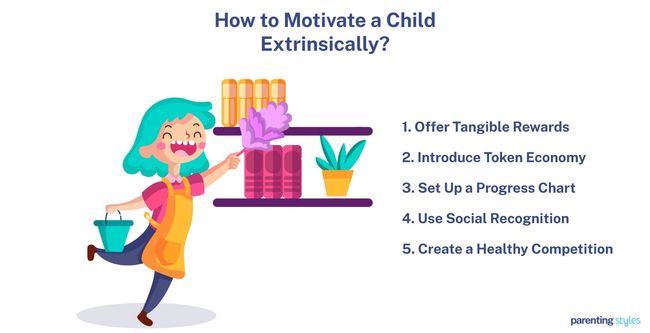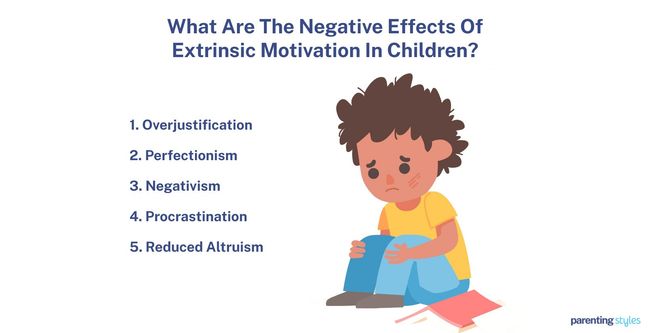Extrinsic Motivation: Definition, Characteristics, And Examples
Extrinsic motivation drives behavior through external outcomes like rewards or punishment rather than enjoyment of the process. Extrinsic motivation tends to generate quick results and is more effective for short-term rather than long-term tasks. The importance of extrinsic motivation lies in its ability to drive immediate behavioral changes in structured environments like schools and workplaces through rewards, competition, and knowledge-sharing incentives.

Extrinsic motivation impacts child growth by enhancing skill acquisition and behavior modification through external rewards and verbal praise that promote sustained effort. Common examples of extrinsic motivation include education (grades), workplace (bonuses), relationships (appreciation), and social media (likes/shares).
Extrinsic motivation relies on external rewards, unlike intrinsic motivation, which stems from internal enjoyment. Extrinsic motivation works better for initially boring tasks or those requiring immediate results.
The key characteristics of extrinsic motivation include external rewards, punishment avoidance, social approval, competition, deadlines, grades, social pressure, obligations, fear of failure, and material benefits.
Children are motivated extrinsically through tangible rewards, token economies, progress charts, social recognition, and healthy competition.
Extrinsic motivation tends to increase focus and task completion in the short term, but it diminishes intrinsic interest and causes stress over time.
Positive effects on children include improved academic performance and appropriate behaviors. Negative effects include overjustification (loss of intrinsic interest), reduced altruism, and increased perfectionism.
Extrinsic and external motivation are generally considered the same in loose terms, though motivation experts note that internal factors like guilt drive extrinsic motivation.
What Is Extrinsic Motivation?
Extrinsic motivation is the drive to do something for outcomes separate from enjoying the process, such as receiving a reward or avoiding punishment. External factors, like rewards or punishment, drive extrinsic motivation. Tangible and intangible rewards include money, grades, praise, fame, or social approval. Punishment avoidance arises from pressures like criticism, fines, or job loss.
Extrinsic motivation drives individuals to perform tasks that are not inherently fulfilling, according to a 2000 study titled “Intrinsic and Extrinsic Motivations: Classic Definitions and New Directions,” conducted by Richard M. Ryan et al. and published in Contemporary Educational Psychology. Extrinsic motivation tends to be effective faster for short-term tasks but is often not sustainable in the long run.
Over-reliance on extrinsic motivation often leads to decreased intrinsic motivation, diminishing returns, and less effectiveness over time. Focusing on outcomes rather than the process overjustifies and crowds out intrinsic motivation.
What Is The Importance Of Extrinsic Motivation?
The importance of extrinsic motivation lies in its ability to drive immediate behavioral change. Extrinsic motivation is pivotal in education, workplaces, and other structured environments where external rewards inspire desired actions. For example, teachers use grades to promote studying. Employers offer bonuses to boost productivity. Extrinsic motivators, such as competition, encourage individuals to excel by outperforming others and improving performance. Jobs lacking inherent fulfillment, such as garbage collection, rely heavily on extrinsic motivation. The fear of imprisonment prevents crimes.
Extrinsic motivation encourages knowledge-sharing behavior, such as employees sharing expertise to build a reputation among peers, according to a 2011 study titled “The influence of intrinsic and extrinsic motivation on individuals’ knowledge sharing behavior,” conducted by Shin-Yuan Hung et al. and published in the International Journal of Human-Computer Studies.
Understanding extrinsic motivation is important for parents, teachers, employers, and leaders. Leveraging extrinsic motivation, systems are designed to inspire desired behaviors, such as collaboration and performance.

How Does Extrinsic Motivation Affect Child Growth?
Extrinsic motivation affects child growth by enhancing skill acquisition, fostering behavior modification, and shaping attitudes toward learning. External rewards, such as tangible incentives or verbal praise, promote sustained effort and improved performance, according to a 2018 study titled “Influence of Extrinsic and Intrinsic Motivation on Pupils Academic Performance in Mathematics,” conducted by Onyekwere Nonye Adamma et al. in Nigeria and published in Supremum Journal of Mathematics Education. Acknowledging children’s efforts and strategies through verbal praise enhances child growth by enabling a growth mindset and motivation to learn. Extrinsic rewards encourage children to associate specific behaviors with external benefits. For example, offering rewards for completing chores or following rules motivates compliance.
What Are The Best Examples Of Extrinsic Motivation?
The best examples of extrinsic motivation are in education, home, workplace, relationships, and community. Below are the 10 best examples of extrinsic motivation.
- Education: Completing assignments on time to earn high grades and avoid penalties from teachers.
- Home: Completing household chores to earn an allowance or privileges, such as additional screen time or going out with friends.
- Workplace: Working extra hours to receive a performance bonus or recognition from management.
- Relationships: Expressing appreciation through a heartfelt note reinforces positive behaviors like active listening.
- Community Involvement: Volunteering to earn recognition from local organizations.
- Gaming: Playing video games to earn in-game rewards.
- Sports: Practicing diligently to win prizes in competitive events.
- Art: Creating artwork to sell.
- Fitness: Going to the gym to fit into clothes.
- Social Media: Creating videos to gather likes and shares.
How Does Extrinsic Motivation Differ From Intrinsic Motivation?
Extrinsic motivation differs from intrinsic motivation in that extrinsic motivation is driven by outcomes separable from enjoying the process, whereas intrinsic motivation is fueled by satisfaction from the activity. Extrinsic motivation relies on external rewards or pressures, such as getting a salary or avoiding penalties. Intrinsic motivation comes from internal factors such as enjoyment, curiosity, interest, passion, or a desire for self-improvement.
Extrinsic motivation works better than intrinsic motivation for initially boring tasks, according to a 2015 study titled “Revisiting the Role of Rewards in Motivation and Learning: Implications of Neuroscientific Research,” conducted by Suanne Hidi and published in Educational Psychology Review. Extrinsic vs intrinsic motivation underscores how rewards encourage children to engage in activities until personal interest develops. Offering stickers as a reward encourages children to complete repetitive handwriting exercises, transforming a dull activity into an engaging one.
Extrinsic motivation requires less effort and time than intrinsic motivation, making it more suitable for tasks demanding immediate results, such as meeting tight deadlines or achieving short-term goals.
What Are The Characteristics Of Extrinsic Motivation?
1. External Rewards
External rewards are incentives from outside an individual, categorized into tangible and intangible. For example, tangible rewards include physical incentives, like gifts, cash, discounts, stickers, or travel vouchers. Intangible rewards provide psychological, emotional, or social reinforcement, like verbal recognition or enhanced community standing.
2. Avoidance Of Punishment
Avoidance of punishment involves behavior driven by the desire to evade negative consequences out of fear. For example, a child finishes homework to avoid losing screen time rather than learning the materials.
3. Approval From Others
Approval from others is driven by the desire to gain recognition, praise, or acceptance from others, such as peers, family, authority figures, or the community. For example, students study hard for an exam to get an A and receive teacher praise, not because they enjoy the subject.
4. Competition
Competition is engaging in activities to outperform others and achieve external recognition, status, or prizes. For example, entering the science fair to win rather than to enjoy the process of pursuing science.
5. Deadlines And Goals
Deadlines and goals are externally imposed time limits or objectives that drive individuals to complete tasks to meet expectations, avoid consequences, or gain rewards. Extrinsic motivation is fueled by the pressure or incentive associated with the external timeframe or benchmarks. For example, an employee works overtime to meet a project deadline, motivated by the promise of a bonus.
6. Grades And Assessments
Schools and teachers use external evaluations or scoring systems to encourage students to study by linking success to grades, rewards, or recognition. Students are driven to study extrinsically by wanting to achieve high marks or avoid failing grades rather than by a genuine interest in learning.
7. Social Pressure
Social pressure is the influence of peers, family, or societal expectations. Social pressure drives individuals to conform to group norms to gain acceptance or avoid criticism. For example, a teenager joins a sports team because their friends are on the team, and they fear being excluded from the social group if they don’t participate, but they don’t enjoy the sports.
8. Obligations And Duties
Obligations and duties are the actions driven by external expectations, responsibilities, or commitments imposed by societal roles, professional requirements, or personal agreements. For example, employees complete a report on time because it is part of their job, not because they enjoy it.
9. Fear Of Failure
Fear of failure is the drive to perform to avoid negative consequences, criticism, or disappointments from others. For example, students study intensely for an exam because they fear receiving a poor grade and disappointing their parents, not because they are passionate about the subject.
10. Material Benefits
Material benefits refer to tangible rewards, such as food, candies, and medals. Material benefits motivate people by fulfilling tangible needs and desires. Access to resources like money, goods, or services often drives individuals to engage in specific behaviors or work toward particular goals by improving quality of life, ensuring security, or offering opportunities for personal growth. For example, financial incentives encourage employees to work overtime, as rewards enhance purchasing power and standard of living.

How To Motivate A Child Extrinsically?
To motivate a child extrinsically, offer tangible rewards, introduce a token economy, set up a progress chart, use social recognition, or create healthy competition. 5 ways to motivate a child extrinsically are listed below.
- Offer Tangible Rewards: Create a system where children receive meaningful rewards for completing tasks or reaching goals. Examples include stickers, certificates, or a small toy after completing homework or achieving a milestone. Clearly outline the reward for every task to maintain consistency and motivation.
- Introduce Token Economy: Token economy involves collecting tokens traded for rewards like toys and free time. Establish a points system where children earn points for positive behaviors or completing assignments. Allow children to exchange points for privileges like extra playtime, choosing a family activity, or a treat. Keep the system transparent and easy to track by using easy-to-distribute, collect, and exchange tangible items for tokens, such as stickers, chips, or points.
- Set Up a Progress Chart: Use a visual progress chart to track accomplishments. For instance, display a chart with steps leading to a prize. Each completed step brings the child closer to earning the reward, clearly showing their progress.
- Use Social Recognition: Publicly acknowledge your child’s achievements by sharing success during family gatherings or displaying completed projects. Positive recognition builds confidence and motivates children to continue their efforts.
- Create a Healthy Competition: Turn tasks into engaging challenges or competitions. For example, set a timer and encourage children to clean up toys before the time runs out, or create a reading challenge with a small prize for finishing a book. Make sure to add a fun element to keep children entertained and motivated to participate.

What Is The Effect Of Extrinsic Motivation?
The effects of extrinsic motivation include positive and negative outcomes. Positive effects include increased focus and task completion, as individuals usually work harder to achieve rewards or avoid penalties. External incentives drive short-term success in achieving clear goals and enhancing productivity. Extrinsic motivation works quickly when tasks lack personal interest or inherent enjoyment.
Negative effects arise when reliance on external rewards diminishes intrinsic interest. Individuals lose interest in activities once incentives are removed, according to a 2015 study titled “Extrinsic and Intrinsic Motivation.” conducted by Beth Hennessey et al. and published in Wiley Encyclopedia of Management. The pressure to meet externally imposed expectations causes stress, resulting in negative behaviors like procrastination.
What Are The Positive Effects Of Extrinsic Motivation In Children?
The positive effects of extrinsic motivation in children include improved academic performance, behaviors, competence, and intervention outcomes. Here are 5 positive effects of extrinsic motivation in children.
- Academic Performance: Extrinsic motivation enhances academic performance, especially when the tasks are uninteresting, according to a 2019 study titled “Multiplicative effect of intrinsic and extrinsic motivation on academic performance: A longitudinal study of Chinese students,” conducted by Yuan Liu et al. in China and published in the Journal of Human Resources. External rewards enhance learning outcomes as long as learners do not become overly reliant on incentives for motivation.
- Appropriate Behaviors: Verbal praise motivates children to behave appropriately in the classroom. Compliments and positive feedback encourage positive mood and confidence, prompting children to repeat the praised behavior.
- Competence: External factors such as positive feedback enhance children’s perceived competence in a task. Children receiving verbal praise develop a positive perception of their abilities, enhancing motivation to complete tasks.
- Intervention Outcomes: Extrinsic motivation is associated with better spatial processing scores in children with ADHD following a behavioral intervention program, according to a 2020 study titled “Examining the Impact of Motivation on Working Memory Training in Youth With ADHD,” conducted by Mahsa Sadeghi et al. and published in the Journal of the Canadian Academy of Child and Adolescent Psychiatry. Incentives and feedback increase children’s interest in the intervention, resulting in better engagement and outcomes.
- Healthy Eating: Providing rewards like cash or prizes increases children’s consumption of fruits and vegetables. Incentives led to an 80% increase in the fraction of children eating a serving of fruits or vegetables during lunch and reduced food waste by 33%, according to a 2013 study titled “Using Incentives to Encourage Healthy Eating in Children,” conducted by David R. Just and Joseph Price and published in The Journal of Human Resources.
Are Extrinsic Motivation And External Motivation The Same?
Yes, extrinsic motivation and external motivation are the same when defined loosely. Both terms are used interchangeably to refer to motivations that arise outside an individual, as used in the 2012 study “Effects of intrinsic and extrinsic motivation on attention and memory” by Lucy J. Robinson et al. and published in Acta Psychologia. Extrinsic and external motivations involve performing tasks for rewards, recognition, or avoidance of punishment in this context.
Motivation experts Richard M. Ryan and Edward L. Deci defined extrinsic motivation as doing something to obtain an outcome separable from enjoyment. Controlling internal factors, such as guilt or anxiety, causes extrinsic motivation, according to the definitions in the Self-Determination Theory depicted in a 2000 study titled “Intrinsic and Extrinsic Motivations: Classic Definitions and New Directions,” conducted by Richard M. Ryan and Edward L. Deci at the University of Rochester and published in Contemporary educational psychology. Therefore, extrinsic and external motivations are different because some internal motivations also cause extrinsic motivation.
What Are The Negative Effects Of Extrinsic Motivation In Children?
The negative effects of extrinsic motivation in children include overjustification, negativism, procrastination, perfectionism, and reduced altruism. Here are 5 negative effects of extrinsic motivation in children.
- Overjustification: Over-justification occurs when a child relying on external rewards loses interest in the activity. The child’s focus shifts to getting the reward, which reduces intrinsic motivation and interest over time. For example, a child rewarded for reading books becomes less interested in reading for pleasure once the rewards are removed. Overjustification negatively affects other child functioning, including learning and school performance.
- Reduced Altruism: External rewards reduce helping behaviors in children during infancy, according to a 2008 study titled “Extrinsic Rewards Undermine Altruistic Tendencies in 20-Month-Olds,” conducted by Felix Warneken and Michael Tomasello, published in Developmental Psychology Journal. Children as young as 20 months old demonstrate an innate tendency to help others, but material or social rewards diminish altruism through the overjustification effect.
- Perfectionism: Perfectionism is the excessive concern about making mistakes. Extrinsic rewards create competition and pressure to meet imposed standards, causing children excessive self-criticism and fear of failure associated with perfectionism.
- Negativism: Negativism is the tendency to focus on the negative aspects of a situation. External factors result in pessimism as children think of shame or punishment. Deadlines, evaluations, and competition create fear, resulting in a negative mindset.
- Procrastination: Procrastination refers to delaying or postponing a task or activity. Reliance on external factors causes stress, anxiety, and self-criticism, prompting children to delay tasks to avoid uncomfortable feelings. For example, a child avoids accepting responsibility for a problem due to feelings of shame or humiliation, as stated in the 2015 study “Is Intrinsic Motivation Better Than Extrinsic Motivation?” conducted by Elaine Clanton Harpine and published in Group-Centered Prevention in Mental Health.
